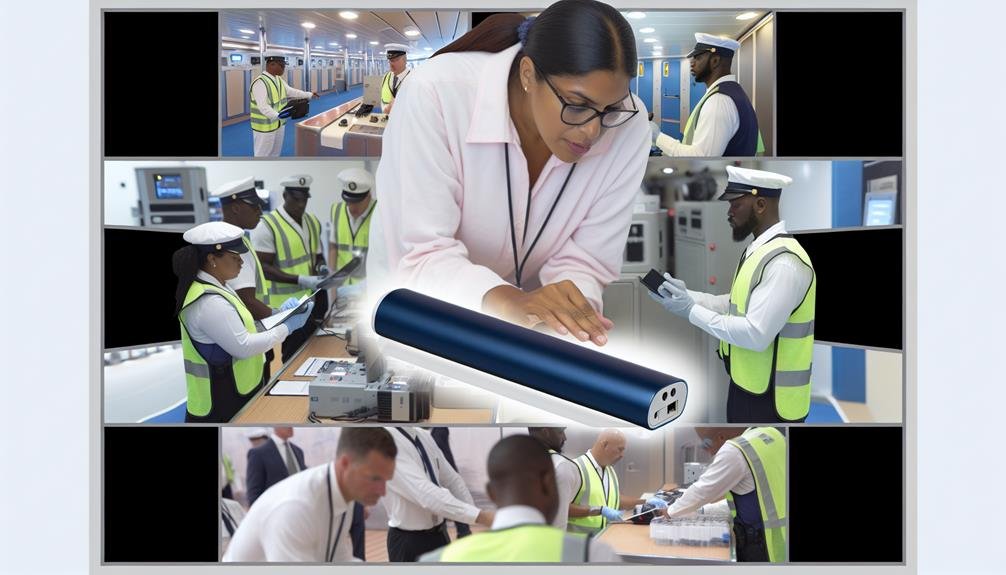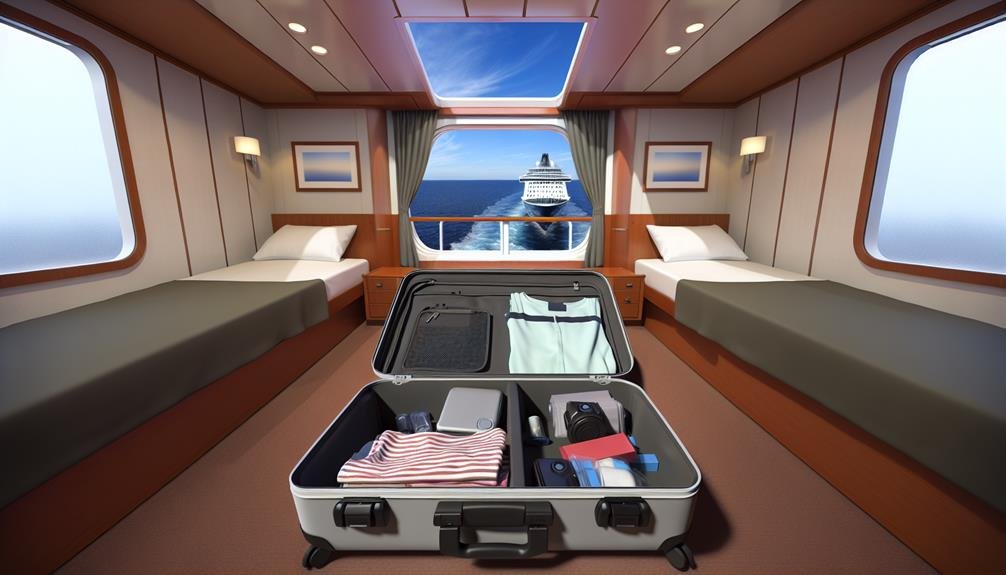Yes, you can bring power banks on most cruise ships, but you'll need to follow specific guidelines. Typically, power banks up to 20,000mAh are allowed, and they should be stored and charged in your cabin. It's vital to confirm they meet the cruise line's electrical standards and are labeled with their capacity. Checking for cruise-specific policies regarding size and weight limits is important. Also, make sure to inspect your power bank for wear and tear to guarantee safety. Understanding these guidelines fully can make a significant impact on your cruise experience.
Cruise Line Policies

Each cruise line has its own specific policies concerning the use and storage of power banks on board. Understanding these policies is fundamental to ensure your safety and compliance throughout your voyage. Generally, cruise lines allow power banks but often have restrictions on their size and capacity. You must check with your specific cruise line to see what's acceptable.
Onboard charging stations and outlet availability are factors that vary significantly between cruise lines. Some ships are well-equipped with numerous outlets in cabins and public areas, while others might have limited access. You'll need to plan accordingly, especially if you're relying on power banks to maintain your devices' battery life.
When it comes to charging speed, cruise lines usually don't impose restrictions, but you should be aware of the power output of available outlets. Some older ships may offer slower charging speeds, which can impact how quickly your power bank recharges. Additionally, storing power banks safely is vital. Most cruise lines recommend keeping them in your cabin and avoiding public areas to prevent accidental damage or theft.
Types of Power Banks
When selecting a power bank for your cruise, you'll need to weigh the differences between lithium-ion and lithium-polymer models. Each type has its own advantages regarding weight, durability, and cost. Additionally, be mindful of capacity and size limits, as most cruise lines have strict policies to guarantee safety.
Lithium-Ion Vs. Lithium-Polymer
Understanding the differences between lithium-ion and lithium-polymer power banks is vital for making an informed choice for your cruise ship needs. Lithium-ion power banks are well-regarded for their efficient charging speed and longer battery life, making them a reliable choice when you need your devices powered up quickly and for extended periods. They tend to be slightly heavier, though, which might impact their portability if you're planning to carry them around the ship frequently.
On the other hand, lithium-polymer power banks are known for their lightweight and slim design, enhancing their portability. This can be a significant advantage if you aim to travel light or have limited storage space in your cabin. However, they generally offer a slower charging speed and shorter battery life compared to their lithium-ion counterparts.
When prioritizing safety, both types are considered safe for use on cruise ships, provided they meet the standard regulations. It's important to handle them properly to avoid any risks, such as overheating or damage. Choose a power bank that aligns with your priorities—whether it's charging speed and battery life or weight and portability—to guarantee a safe and convenient cruise experience.
Capacity and Size Limits
Selecting the appropriate power bank for a cruise involves understanding the capacity and size limits imposed by cruise lines to ensure safety and compliance. Most cruise lines have specific weight restrictions and dimensions regulations for power banks. Typically, power banks with a capacity of up to 20,000mAh are allowed, but anything exceeding this may be prohibited.
Here's a quick reference table to help you grasp the common size limitations and capacity requirements:
| Capacity Range | Typical Cruise Line Policy |
|---|---|
| Up to 10,000mAh | Generally Allowed |
| 10,001mAh to 20,000mAh | Allowed with Specific Conditions |
| Above 20,000mAh | Often Prohibited |
When considering weight restrictions, remember that the power bank's weight should ideally be under 1 pound (approximately 450 grams). Dimensions regulations generally specify that the device should fit comfortably in your hand luggage without occupying excessive space. It's crucial to check the specific guidelines of your cruise line before you pack your power bank.
Safety Regulations

To guarantee the safety of all passengers, cruise ships have stringent regulations governing the use and storage of power banks. You should be aware of specific charging restrictions that safeguard your device doesn't pose a risk. Most cruise lines mandate that power banks can only be charged in your cabin and not in public areas. This minimizes the chance of unattended devices causing overheating or fires.
Safety precautions are paramount when bringing power banks on board. You'll find that cruise ships often require you to store your power bank in a designated safe area within your cabin when it's not in use. This is to prevent accidental activation or damage that could lead to hazards. Additionally, it's vital to regularly inspect your power bank for any signs of wear and tear, such as frayed cables or swollen batteries, before your trip.
Understanding these regulations helps ensure a safe and enjoyable cruise experience for everyone on board. By following the outlined safety measures, you're not only protecting yourself but also contributing to the overall security of the vessel. Always adhere to crew instructions regarding power bank usage to avoid any potential safety issues.
Capacity Limits
When you're packing your power bank for a cruise, it's important to understand the maximum capacity regulations set by the cruise line. Most ships have strict limits on the battery capacity and the number of devices you can bring onboard to guarantee passenger safety. Adhering to these guidelines helps maintain compliance with international safety standards and prevents any disruptions to your travel plans.
Maximum Capacity Regulations
Most cruise lines enforce strict regulations on the maximum capacity of power banks you can bring aboard to guarantee passenger safety and compliance with international maritime laws. These capacity restrictions are in place primarily due to safety concerns, as high-capacity power banks can pose fire risks if not handled correctly. When traveling with power banks, knowing the specific guidelines of your cruise line is crucial to avoid any issues at the start of the journey.
Typically, cruise lines limit power banks to a maximum capacity of 20,000mAh. However, there can be variations, so always check with your specific cruise provider. Here's a quick reference table for commonly regulated capacities:
| Cruise Line | Maximum Capacity (mAh) |
|---|---|
| Cruise Line A | 20,000 |
| Cruise Line B | 15,000 |
| Cruise Line C | 20,000 |
It's also prudent to assess your charging options while on board. Many cabins have limited electrical outlets, so having a compliant power bank can be a lifesaver for keeping your devices charged. Always store and use your power bank according to the manufacturer's instructions to minimize any safety risks. By following these regulations, you're contributing to a safer travel environment for everyone on the ship.
Permitted Device Limits
In addition to capacity regulations, cruise lines also impose strict limits on the number of power banks you can bring aboard to guarantee the safety of all passengers. These power bank restrictions are designed to mitigate potential risks associated with lithium-ion batteries, which can pose a fire hazard if not properly managed. Each cruise line has its own specific rules, so it's important to check their guidelines before you pack.
Generally, most cruise ship regulations allow you to carry up to two power banks per person. However, these allowed devices must adhere not only to the number limit but also to capacity restrictions. For instance, power banks typically need to be under a specific watt-hour (Wh) threshold, often around 100 Wh, to comply with international safety standards.
Charging restrictions also play a role in these regulations. While power banks are convenient for keeping your devices charged during your cruise, be mindful that some cruise lines prohibit charging power banks in staterooms due to fire safety concerns. Instead, they may have designated charging areas where you can safely recharge your devices.
Understanding these power bank restrictions and cruise ship regulations ensures you're prepared, compliant, and most importantly, secure during your voyage.
Safety Compliance Standards
Cruise lines enforce strict safety compliance standards on power bank capacity limits to minimize fire hazards and safeguard passenger safety. When you're packing for your voyage, it's essential to understand these limitations to guarantee a smooth boarding process. Adhering to these guidelines not only secures your safety but also the safety of all passengers and crew on board.
Here are the primary aspects you need to be aware of:
- Capacity Limits: Most cruise lines restrict power banks to a maximum capacity of 20,000mAh. Anything above this limit may be subject to confiscation during safety inspections.
- Device Compatibility: Confirm your power bank is compatible with your devices and complies with the cruise line's electrical standards. Non-compliant devices can pose significant risks.
- Labeling and Certification: Your power bank should have clear labeling indicating its capacity and must be certified by recognized safety standards. This aids during inspections and ensures you're carrying a safe device.
- Inspection Readiness: Be prepared for your power bank to be inspected at boarding. It's wise to have documentation or proof of certification readily available to prevent any delays.
Packing Tips

When packing for your cruise, make sure you bring a high-capacity power bank to keep your devices charged throughout your journey. It's crucial to grasp charging etiquette, particularly when sharing limited power outlets in your cabin. Not everyone packs enough chargers, so be considerate and don't leave your devices plugged in longer than necessary.
International adapters and voltage converters are vital if your cruise has international stops. Different countries have varying power outlet types and voltage standards, so having the right equipment guarantees your devices charge safely without damaging them. Many modern power banks come with built-in safety features, but it's always best to double-check compatibility with your electronics.
Remember to pack a few extra USB cables and a surge protector. While cruise ships generally have power outlets in each cabin, they might be limited. A surge protector with multiple ports can help you manage multiple devices simultaneously, making sure all your gadgets are ready to go.
Lastly, always follow the cruise line's specific guidelines about power banks and other electronic devices. Some ships have restrictions on the type or capacity of power banks allowed onboard, so verify these details before you set sail. By being well-prepared, you'll enjoy a smooth and safe cruising experience.
Alternative Charging Options
Beyond traditional power banks, exploring alternative charging options can guarantee your devices stay powered up throughout your cruise. These options not only provide flexibility but also adhere to safety guidelines that cruise lines often enforce.
- Solar Chargers: Solar chargers are an excellent eco-friendly alternative. They harness the sun's energy, which is abundant while you're at sea. Make sure you get a model with a high conversion rate for efficiency. Just place it on your cabin's balcony or any sunny spot on the deck.
- Wireless Chargers: Wireless chargers can be a convenient option for devices compatible with this technology. They reduce the clutter of cables and are generally compact. Opt for a model that supports fast charging to make the most of your time.
- Portable Generator Units: These are more robust than standard power banks and can charge multiple devices simultaneously. Be sure to check the cruise line's policy as some may have restrictions on certain types.
- USB Ports and Outlets: Many modern cruise ships come equipped with USB ports and outlets in cabins and common areas. Utilize these to charge your devices directly, reducing the need to carry additional hardware.
Frequently Asked Questions
Can I Use My Power Bank in My Cabin?
Yes, you can use your power bank in your cabin, but guarantee power bank safety by following the cruise line's guidelines. Be conscious of power bank charging limitations and never leave it unattended while charging.
Are Power Banks Available for Purchase on Board?
Yes, you can purchase power banks on board. However, make sure power bank compatibility with your devices and review power bank charging options available on the ship for safety. Always follow ship guidelines for electronic device usage.
Do Power Banks Work With All Types of Electronic Devices?
When it comes to power bank compatibility, not all devices are created equal. Have you considered the charging limitations? Most power banks work with popular gadgets, but always check specifications to guarantee your device charges safely and efficiently.
Can I Rent a Power Bank on the Cruise Ship?
Yes, you can rent a power bank on the cruise ship. Power bank rentals comply with cruise ship regulations, ensuring they're safe and reliable for your devices. Always check with your cruise line for specific rental policies.
What Should I Do if My Power Bank Gets Lost on the Ship?
Losing a power bank on a cruise ship can feel like losing your lifeline. Report the lost item to the ship's lost and found immediately. Familiarize yourself with their policies and explore replacement options onboard for safety.



